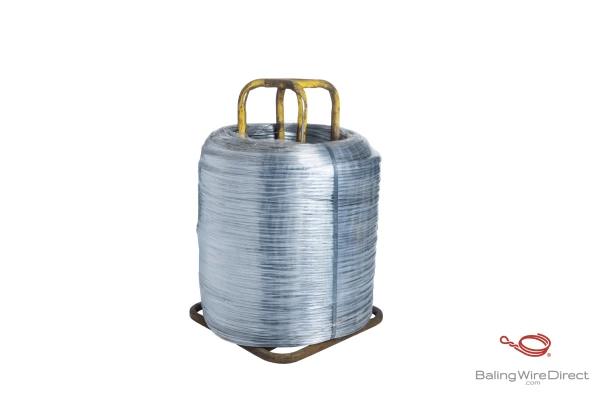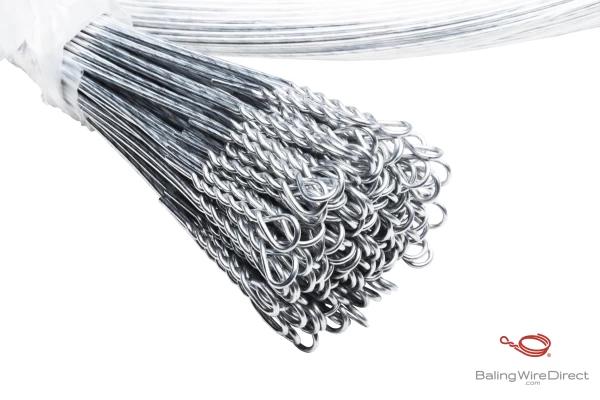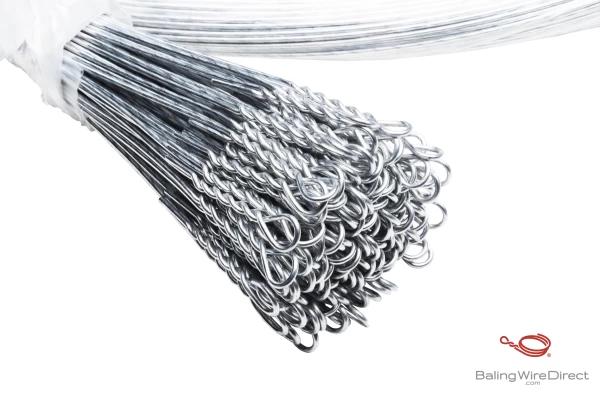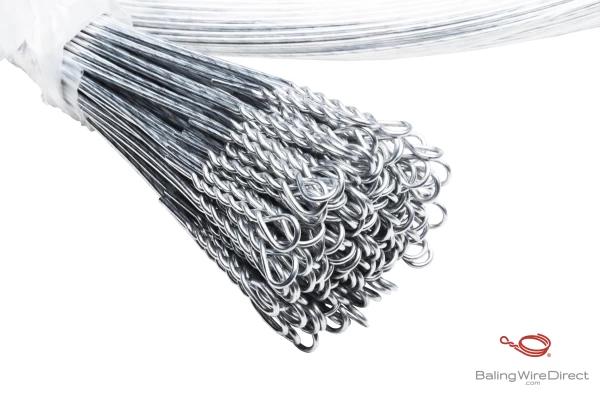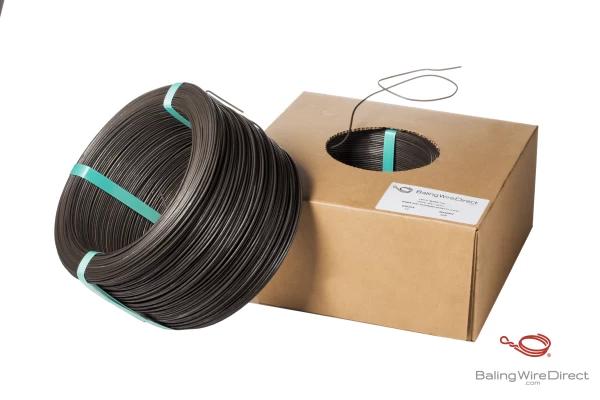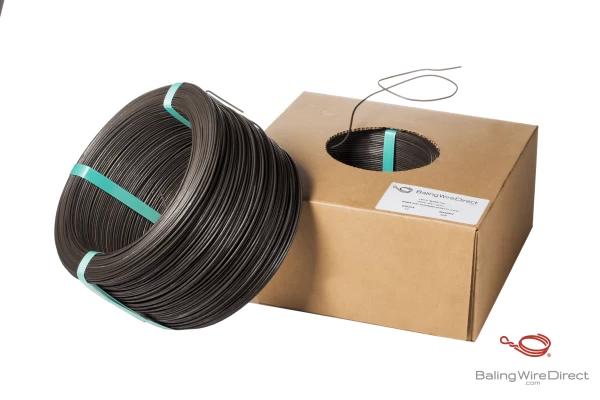9 Gauge Galvanized Oval Double Loop Bale Ties
$65.00$71.50
LENGTH (INCHES)
TIES PER BUNDLE
Add to cart to calculate freight
Product details
| Wire gauge | 9 Gauge |
| Load strength | 2,040 lbs. |
| Tensile strength | 220,000 psi (1516.85 MPa) |
| Diameter (inch/mm) | SWG (.144" / 3.658 mm) | Actual Size (.148" / 3.7592 mm) |
Product specifications
Designed for vertical, down-stroke, and horizontal balers, our 9-gauge Galvanized Double Loop Bale Ties withstand 220,000 pounds per square inch (PSI) and boast a total load strength of 2040 lbs.
| Wire gauge | 9 Gauge |
| Load strength | 2,040 lbs. |
| Tensile strength | 220,000 psi (1516.85 MPa) |
| Diameter (inch/mm) | Standard Wire Gauge or SWG (.144" / 3.658 mm) | Actual Size (.148" / 3.7592 mm) |
| Elongation | 4% |
| Carbon grade | 1080 |
| Ties per bundle | 50, 62, 125 |
| Custom lengths | 120" - 234" |
| Quality control | Extensive testing |
| Finish | Galvanized |
Double loop bale tie use cases
Our double loop bale ties are used in the recycling industry to bale tires, foam, cardboard, paper, plastic, PET, aluminum, steel, metal, and other materials.
The galvanizing process explained
We follow a 7-step hot-dip process galvanization process to enhance our wire products:
- Surface preparation: first, the wire is cleaned to remove any surface impurities. This ensures proper adhesion of the zinc coating.
- Pickling: the wire is immersed in an acid solution to remove any remaining oxides and scale. This process prepares the surface for galvanizing by creating a clean substrate.
- Fluxing: the wire is then immersed in a flux solution (zinc ammonium chloride), which prevents oxidation and promotes a uniform application of the zinc coating.
- Galvanizing bath: next, the wire is dipped into a 450°C (850°F) bath of molten zinc.
- Alloy formation: while immersed in the molten zinc, a metallurgical reaction occurs between the iron in the wire and the zinc, resulting in the formation of a series of zinc-iron alloy layers. These provide excellent abrasion and corrosion resistance.
- Withdrawal: the wire is gradually withdrawn from the zinc bath. The rate at which the withdrawal takes place is controlled to allow excess zinc to drain off and ensure the final product has an even coating.
- Quenching: the coated wire is then quenched in water or a quenching solution to cool it rapidly. This process solidifies the zinc coating and completes the galvanizing process.
After galvanization, we apply an additional microcrystalline wax coat to further protect our wire products.
Class 1 and Class 3 galvanization
Baling Wire Direct offers Class 1 and Class 3 galvanized wire. Class 1 is more cost-effective for those on a tight budget, but degrades faster than Class 3 galvanization, which creates a thicker zinc coating to improve performance and longevity:
- Class 1 galvanization is the most basic type of galvanized coating, typically used in the farming industry for fencing, caging, and enclosure purposes. Wire is galvanized by adding a thin layer of zinc, making it the more cost-efficient but less long-lasting option. Class 1 galvanized wire fences start to rust quickly, typically lasting a maximum of 11 years, and as little as 2. In a coastal area with heavy concentrations of salt water in the air, it deteriorates even faster.
- Class 3 galvanization provides a stronger, longer-lasting zinc coating. Whereas Class 1 uses 0.28 ounces of zinc per square foot, Class 3 galvanized wire has a zinc coating that is nearly three times thicker (approximately 0.80 ounces per square foot). It costs slightly more than Class 1, but will last anywhere from 13–30 years before it rusts, making it well worth the investment.
Quality is our priority
Baling Wire Direct is one of the largest baling wire manufacturing companies in North America. That's why we strive to provide our customers with the highest quality products. Our baler wire is created under the highest standards of quality and performance.
Our dedication to quality is unparalleled, and we carry out meticulous testing on all of our products to ensure they perform to the highest industry standards. The wire that fails to pass our quality testing is removed from stock, ensuring only strong and reliable carrier wire reaches our customers.
BWD controls every aspect of production and distribution, which allows us to deliver premium products at the lowest prices, with unparalleled customer service.
Our Autoship™ system keeps you informed every step of the way to deliver the smoothest possible purchasing experience. Receive tracking information via email or text message. Enjoy quick delivery in as little as 1–3 business days!
Galvanized bale ties versus bright bale ties
We sell double-loop quality ties in two finishes: galvanized and bright. While both are used to bundle materials together, their coating gives them different advantages.
Galvanized wire ties are better when:
- Bales will be stored in contact with the elements
- The material baled is corrosive
Bright finished ties, or raw steel ties, have no additional coating added to them. They are best when:
- Budget is a priority
- The bales might expand (bright bale ties have more elasticity than galvanized)
- Bales are client-facing, requiring a slightly nicer appearance.
The choice between galvanized and bright bale ties depends on the specific requirements of the baling operation, including the type of material being baled, the environmental conditions, and the need for corrosion resistance. If a bright finish makes sense, consider our 9 gauge bright double loop bale ties.
Other wire products we sell
We offer a wide range of additional products beyond double loop bale ties. Other wire products we sell include galvanized wire, black annealed wire, single loop bale ties, and more.









